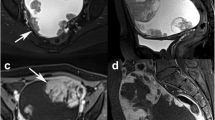Abstract
Purpose
To retrospectively compare the MR findings of histological subtypes of clear cell carcinomas (CCCs) of the ovary.
Materials and methods
This single-center retrospective study was approved by the institutional review board, and the requirement for informed consent was waived. Between April 2005 and August 2015, we found 51 consecutive patients with histopathologically proven CCCs. Among them, 44 CCCs in 37 patients who underwent preoperative MR imaging were included. CCCs were pathologically divided into three subgroups: (1) four clear cell adenofibroma-associated CCCs, (2) 21 endometriosis-associated CCCs, and (3) 19 indeterminate CCCs. The statistical tests were used to compare the frequency of qualitative assessments and value of quantitative measurements among the histological subtypes.
Results
On T2-weighted images, hypointense areas within solid components were more frequently observed in clear cell adenofibroma-associated CCCs [3/4 (75%)] than in the remaining CCCs [1/40 (3%)] (p < 0.01), and the signal intensity ratios (SIRs) of solid components were significantly lower in clear cell adenofibroma-associated CCCs (0.27 ± 0.13) than in the remaining CCCs (0.61 ± 0.18) (p < 0.01). On T1-weighted images, hyperintensities of cystic components were more frequently observed in the endometriosis-associated CCCs [17/21 (81%)] than in the remaining CCCs [5/20 (25%)] (p < 0.01), and the SIRs of cystic components were significantly higher in endometriosis-associated CCCs (2.99 ± 1.51) than in the remaining CCCs (1.82 ± 1.10) (p < 0.01).
Conclusion
MR features may help differentiate between adenofibroma-associated and endometriosis-associated CCC.




Similar content being viewed by others
References
O’Brien ME, Schofield JB, Tan S, et al. (1993) Clear cell epithelial ovarian cancer (mesonephroid): bad prognosis only in early stages. Gynecol Oncol 49:250–254
Yamamoto S, Tsuda H, Takano M, et al. (2008) Clear-cell adenofibroma can be a clonal precursor for clear-cell adenocarcinoma of the ovary: a possible alternative ovarian clear-cell carcinogenic pathway. J Pathol 216:103–110
Okamoto A, Glasspool RM, Mabuchi S, et al. (2014) Gynecologic Cancer InterGroup (GCIG) consensus review for clear cell carcinoma of the ovary. Int J Gynecol Cancer 24:S20–25
Yamamoto S, Tsuda H, Suzuki K, et al. (2009) An allelotype analysis indicating the presence of two distinct ovarian clear-cell carcinogenic pathways: endometriosis-associated pathway vs. clear-cell adenofibroma-associated pathway. Virchows Arch 455:261–270
Yamamoto S, Tsuda H, Yoshikawa T, et al. (2007) Clear cell adenocarcinoma associated with clear cell adenofibromatous components: a subgroup of ovarian clear cell adenocarcinoma with distinct clinicopathologic characteristics. Am J Surg Pathol 31:999–1006
Roth LM, Langley FA, Fox H, et al. (1984) Ovarian clear cell adenofibromatous tumors. Benign, of low malignant potential, and associated with invasive clear cell carcinoma. Cancer 53:1156–1163
Bell DA, Scully RE (1985) Benign and borderline clear cell adenofibromas of the ovary. Cancer 56:2922–2931
Zhao C, Wu LS, Barner R (2011) Pathogenesis of ovarian clear cell adenofibroma, atypical proliferative (borderline) tumor, and carcinoma: clinicopathologic features of tumors with endometriosis or adenofibromatous components support two related pathways of tumor development. J Cancer 2:94–106
Matsuoka Y, Ohtomo K, Araki T, et al. (2001) MR imaging of clear cell carcinoma of the ovary. Eur Radiol 11:946–951
Manabe T, Hirose Y, Kiryuu T, et al. (2007) Magnetic resonance imaging of endometrial cancer and clear cell cancer. J Comput Assist Tomogr 31:229–235
Recio FO, Piver MS, Hempling RE, et al. (1996) Lack of improved survival plus increase in thromboembolic complications in patients with clear cell carcinoma of the ovary treated with platinum versus nonplatinum-based chemotherapy. Cancer 78:2157–2163
Matsuura Y, Robertson G, Marsden DE, et al. (2007) Thromboembolic complications in patients with clear cell carcinoma of the ovary. Gynecol Oncol 104:406–410
Sugiyama T, Kamura T, Kigawa J, et al. (2000) Clinical characteristics of clear cell carcinoma of the ovary: a distinct histologic type with poor prognosis and resistance to platinum-based chemotherapy. Cancer 88:2584–2589
Veras E, Mao TL, Ayhan A, et al. (2009) Cystic and adenofibromatous clear cell carcinomas of the ovary: distinctive tumors that differ in their pathogenesis and behavior: a clinicopathologic analysis of 122 cases. Am J Surg Pathol 33:844–853
Takeuchi M, Matsuzaki K, Uehara H, et al. (2013) Clear cell adenocarcinoma arising from clear cell adenofibroma of the ovary: value of DWI and DCE-MRI. Magn Reson Med Sci 12:305–308
Takeuchi M, Matsuzaki K, Kusaka M, et al. (2003) Ovarian cystadenofibromas: characteristic magnetic resonance findings with pathologic correlation. J Comput Assist Tomogr 27:871–873
Sugiyama K, Takehara Y (2007) Magnetic resonance findings of clear-cell adenocarcinofibroma of the ovary. Acta Radiol 48:704–706
Ogawa S, Kaku T, Amada S, et al. (2000) Ovarian endometriosis associated with ovarian carcinoma: a clinicopathological and immunohistochemical study. Gynecol Oncol 77:298–304
Munksgaard PS, Blaakaer J (2012) The association between endometriosis and ovarian cancer: a review of histological, genetic and molecular alterations. Gynecol Oncol 124:164–169
Chamie LP, Blasbalg R, Pereira RM, et al. (2011) Findings of pelvic endometriosis at transvaginal US, MR imaging, and laparoscopy. Radiographics 31:E77–100
Author information
Authors and Affiliations
Corresponding author
Ethics declarations
Conflicts of interest
The authors declare that there is no conflict of interest associated with this article.
Ethical approval
All procedures performed in studies involving human participants were in accordance with the ethical standards of the institutional and/or national research committee and with the 1964 Helsinki declaration and its later amendments or comparable ethical standards. This article does not contain any studies with animals performed by any of the authors.
Informed consent
This study was approved by our institutional review board and complied with the guidelines of the Healthcare Insurance Portability and Accountability Act. Written informed consent was waived because this study was retrospective.
Rights and permissions
About this article
Cite this article
Kato, H., Hatano, Y., Makino, H. et al. Clear cell carcinoma of the ovary: comparison of MR findings of histological subtypes. Abdom Radiol 41, 2476–2483 (2016). https://doi.org/10.1007/s00261-016-0777-9
Published:
Issue Date:
DOI: https://doi.org/10.1007/s00261-016-0777-9




